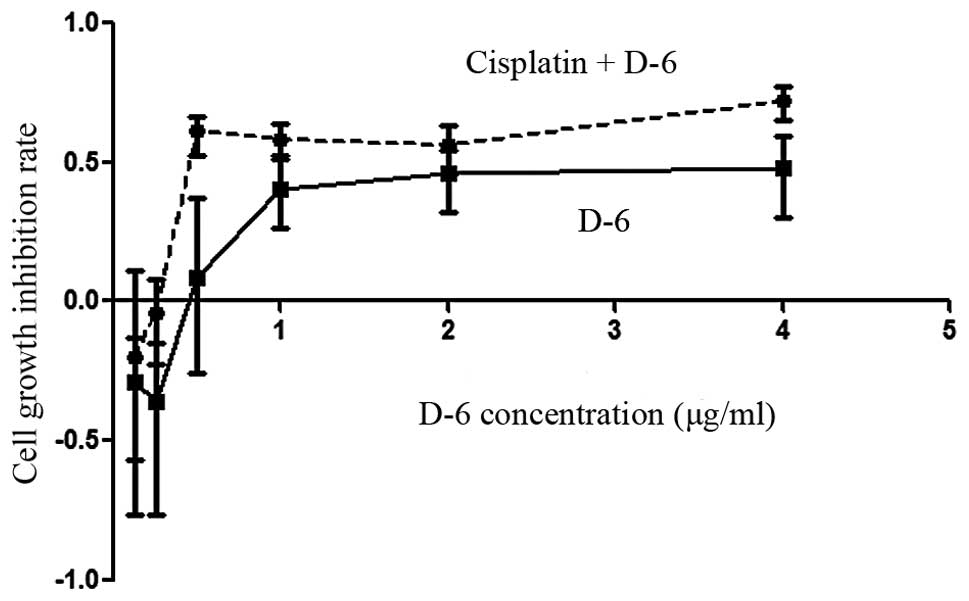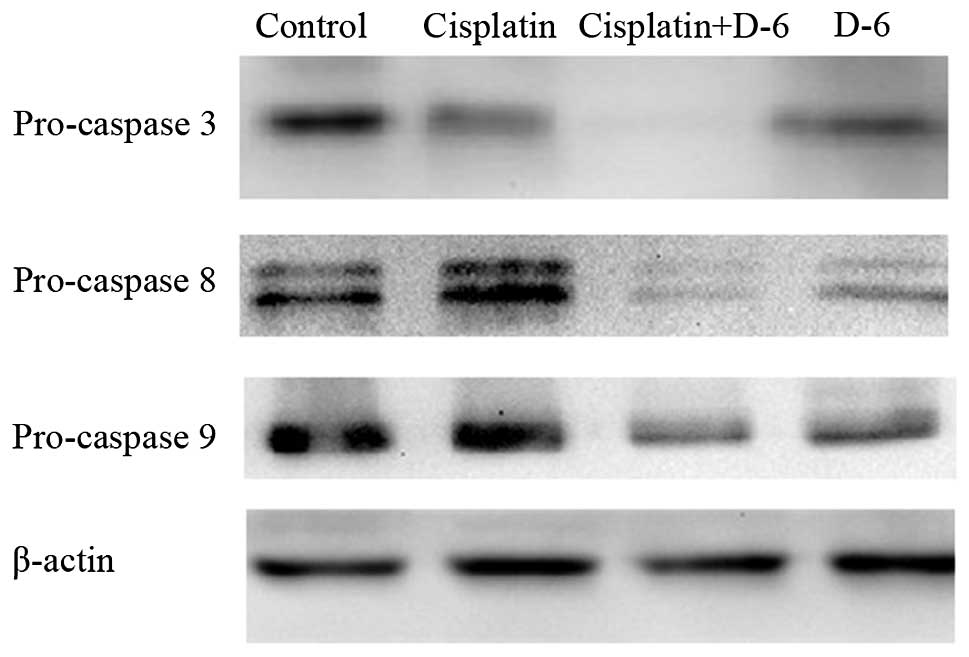|
1
|
Fialka I, Pasquali C, Kurzbauer R,
Lottspeich F and Huber LA: Loss of epithelial polarity is
accompanied by differential association of proteins with
intracellular membranes. Electrophoresis. 20:331–343. 1999.
View Article : Google Scholar : PubMed/NCBI
|
|
2
|
Jemal A, Siegel R, Xu J and Ward E: Cancer
statistics, 2010. CA Cancer J Clin. 60:277–300. 2010. View Article : Google Scholar
|
|
3
|
Pitti RM, Marsters SA, Ruppert S, Donahue
CJ, Moore A and Ashkenazi A: Induction of apoptosis by Apo-2
ligand, a new member of the tumor necrosis factor cytokine family.
J Biol Chem. 271:12687–12690. 1996. View Article : Google Scholar : PubMed/NCBI
|
|
4
|
Wiley SR, Schooley K, Smolak PJ, et al:
Identification and characterization of a new member of the TNF
family that induces apoptosis. Immunity. 3:673–682. 1995.
View Article : Google Scholar : PubMed/NCBI
|
|
5
|
Lacour S, Hammann A, Wotawa A, Corcos L,
Solary E and Dimanche-Boitrel MT: Anticancer agents sensitize tumor
cells to tumor necrosis factor-related apoptosis-inducing
ligand-mediated caspase-8 activation and apoptosis. Cancer Res.
61:1645–1651. 2001.
|
|
6
|
Ma Y, Yang D and Chen Y: Analysis of TRAIL
receptor expression using anti-TRAIL death receptor-5 monoclonal
antibodies. Chin Med J (Engl). 116:947–950. 2003.PubMed/NCBI
|
|
7
|
Jo M, Kim TH, Seol DW, et al: Apoptosis
induced in normal human hepatocytes by tumor necrosis
factor-related apoptosis-inducing ligand. Nat Med. 6:564–567. 2000.
View Article : Google Scholar : PubMed/NCBI
|
|
8
|
Nitsch R, Bechmann I, Deisz RA, et al:
Human brain-cell death induced by tumour-necrosis-factor-related
apoptosis-inducing ligand (TRAIL). Lancet. 356:827–828. 2000.
View Article : Google Scholar : PubMed/NCBI
|
|
9
|
Jiang Q, Zhu H, Liang B, Huang Y and Li C:
Apoptosis-inducing effect of the DR5 monoclonal antibody, D-6,
alone or in combination with cisplatin, on A2780 ovarian cancer
cells. Mol Med Rep. 6:316–320. 2012.PubMed/NCBI
|
|
10
|
Guo Y, Chen C, Zheng Y, et al: A novel
anti-human DR5 monoclonal antibody with tumoricidal activity
induces caspase-dependent and caspase-independent cell death. J
Biol Chem. 280:41940–41952. 2005. View Article : Google Scholar : PubMed/NCBI
|
|
11
|
Yagita H, Takeda K, Hayakawa Y, Smyth MJ
and Okumura K: TRAIL and its receptors as targets for cancer
therapy. Cancer Sci. 95:777–783. 2004. View Article : Google Scholar : PubMed/NCBI
|
|
12
|
Pukac L, Kanakaraj P, Humphreys R, et al:
HGS-ETR1, a fully human TRAIL-receptor 1 monoclonal antibody,
induces cell death in multiple tumour types in vitro and in vivo.
Br J Cancer. 92:1430–1441. 2005. View Article : Google Scholar : PubMed/NCBI
|
|
13
|
Gibson SB, Oyer R, Spalding AC, Anderson
SM and Johnson GL: Increased expression of death receptors 4 and 5
synergizes the apoptosis response to combined treatment with
etoposide and TRAIL. Mol Cell Biol. 20:205–212. 2000. View Article : Google Scholar : PubMed/NCBI
|
|
14
|
Wu GS, Burns TF, McDonald ER III, et al:
KILLER/DR5 is a DNA damage-inducible p53-regulated death receptor
gene. Nat Genet. 17:141–143. 1997. View Article : Google Scholar : PubMed/NCBI
|
|
15
|
Sheikh MS, Burns TF, Huang Y, et al:
p53-dependent and -independent regulation of the death receptor
KILLER/DR5 gene expression in response to genotoxic stress and
tumor necrosis factor alpha. Cancer Res. 58:1593–1598.
1998.PubMed/NCBI
|
|
16
|
Rajeshkumar NV, Rasheed ZA, García-García
E, et al: A combination of DR5 agonistic monoclonal antibody with
gemcitabine targets pancreatic cancer stem cells and results in
long-term disease control in human pancreatic cancer model. Mol
Cancer Ther. 9:2582–2592. 2010. View Article : Google Scholar
|
|
17
|
Er E, Oliver L, Cartron PF, Juin P, Manon
S and Vallette FM: Mitochondria as the target of the pro-apoptotic
protein Bax. Biochim Biophys Acta. 1757:1301–1311. 2006. View Article : Google Scholar : PubMed/NCBI
|
|
18
|
Bevis KS, McNally LR, Sellers JC, et al:
Anti-tumor activity of an anti-DR5 monoclonal antibody, TRA-8, in
combination with taxane/platinum-based chemotherapy in an ovarian
cancer model. Gynecol Oncol. 121:193–199. 2011. View Article : Google Scholar : PubMed/NCBI
|
|
19
|
Li W, Wang S, Chen C and Zhuang G:
Induction of tumor cell apoptosis via Fas/DR5. Cell Mol Immunol.
3:467–471. 2006.PubMed/NCBI
|
|
20
|
Ohtsuka T, Buchsbaum D, Oliver P, Makhija
S, Kimberly R and Zhou T: Synergistic induction of tumor cell
apoptosis by death receptor antibody and chemotherapy agent through
JNK/p38 and mitochondrial death pathway. Oncogene. 22:2034–2044.
2003. View Article : Google Scholar : PubMed/NCBI
|
|
21
|
Ohtsuka T and Zhou T: Bisindolylmaleimide
VIII enhances DR5-mediated apoptosis through the MKK4/JNK/p38
kinase and the mitochondrial pathways. J Biol Chem.
277:29294–29303. 2002. View Article : Google Scholar : PubMed/NCBI
|
|
22
|
Estes JM, Oliver PG, Straughn JM Jr, et
al: Efficacy of anti-death receptor 5 (DR5) antibody (TRA-8)
against primary human ovarian carcinoma using a novel ex vivo
tissue slice model. Gynecol Oncol. 105:291–298. 2007. View Article : Google Scholar : PubMed/NCBI
|
|
23
|
Kang Z, Chen JJ, Yu Y, et al: Drozitumab,
a human antibody to death receptor 5, has potent antitumor activity
against rhabdomyosarcoma with the expression of caspase-8
predictive of response. Clin Cancer Res. 17:3181–3192. 2011.
View Article : Google Scholar : PubMed/NCBI
|
|
24
|
Yada A, Yazawa M, Ishida S, et al: A novel
humanized anti-human death receptor 5 antibody CS-1008 induces
apoptosis in tumor cells without toxicity in hepatocytes. Ann
Oncol. 19:1060–1067. 2008. View Article : Google Scholar : PubMed/NCBI
|
|
25
|
Jin H, Yang R, Ross J, et al: Cooperation
of the agonistic DR5 antibody apomab with chemotherapy to inhibit
orthotopic lung tumor growth and improve survival. Clin Cancer Res.
14:7733–7740. 2008. View Article : Google Scholar : PubMed/NCBI
|
|
26
|
Straughn JM Jr, Oliver PG, Zhou T, et al:
Anti-tumor activity of TRA-8 anti-death receptor 5 (DR5) monoclonal
antibody in combination with chemotherapy and radiation therapy in
a cervical cancer model. Gynecol Oncol. 101:46–54. 2006. View Article : Google Scholar : PubMed/NCBI
|
|
27
|
Kaplan-Lefko PJ, Graves JD, Zoog SJ, et
al: Conatumumab, a fully human agonist antibody to death receptor
5, induces apoptosis via caspase activation in multiple tumor
types. Cancer Biol Ther. 9:618–631. 2010. View Article : Google Scholar : PubMed/NCBI
|
|
28
|
Kindler HL, Richards DA, Garbo LE, et al:
A randomized, placebo-controlled phase 2 study of ganitumab (AMG
479) or conatumumab (AMG 655) in combination with gemcitabine in
patients with metastatic pancreatic cancer. Ann Oncol.
23:2834–2842. 2012. View Article : Google Scholar : PubMed/NCBI
|
|
29
|
Chaudhary PM, Eby M, Jasmin A, Bookwalter
A, Murray J and Hood L: Death receptor 5, a new member of the TNFR
family, and DR4 induce FADD-dependent apoptosis and activate the
NF-kappaB pathway. Immunity. 7:821–830. 1997. View Article : Google Scholar : PubMed/NCBI
|
|
30
|
Buchsbaum DJ, Zhou T, Grizzle WE, et al:
Antitumor efficacy of TRA-8 anti-DR5 monoclonal antibody alone or
in combination with chemotherapy and/or radiation therapy in a
human breast cancer model. Clin Cancer Res. 9:3731–3741.
2003.PubMed/NCBI
|















